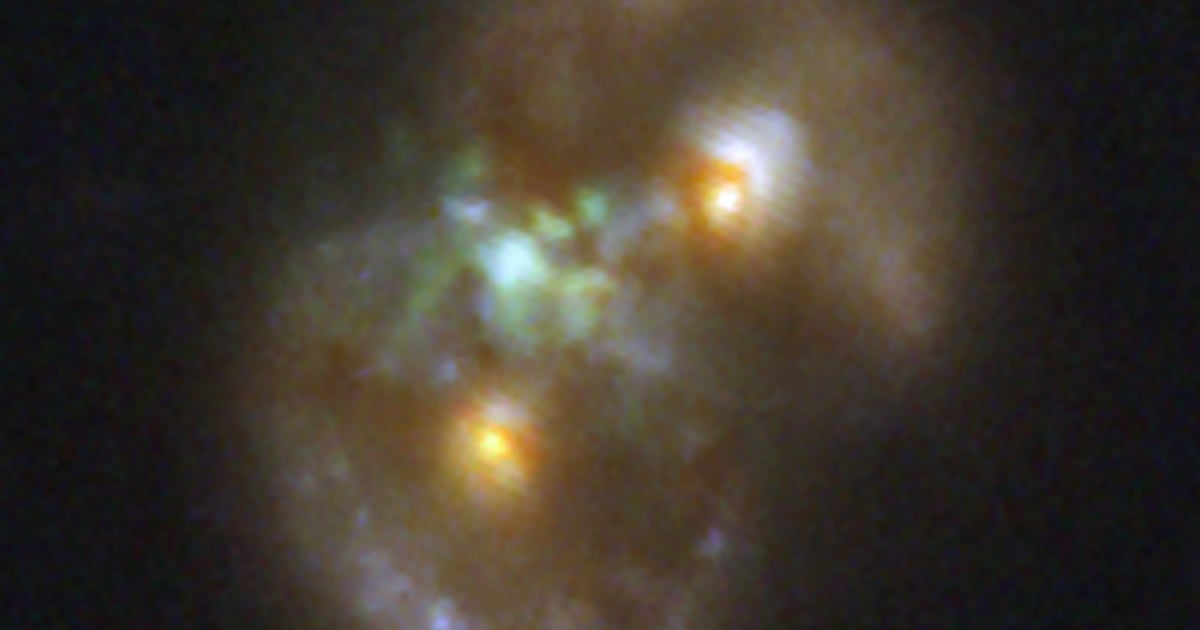A mysterious black hole spotted between two galaxies that are crashing into each other is challenging existing theories on how these powerful cosmic objects are formed.
Researchers behind the study were surprised as black holes are typically found at the centre of galaxies, not floating between them.
The discovery was made using Nasa’s James Webb Space Telescope (JWST), which captured images of two distant galaxies merging in a collision.
Released on Tuesday, the image shows the black hole appearing as a bright glow between the galaxies.
“Finding a black hole that’s not in the nucleus of a massive galaxy is in itself unusual, but what’s even more unusual is the story of how it may have gotten there,” said Dr Pieter van Dokkum, professor of astronomy and physics at Yale University and lead author of the study.
“It likely didn’t just arrive there, but instead it formed there, and pretty recently.
“In other words, we think we’re witnessing the birth of a supermassive black hole, something that has never been seen before.”
Scientists have been studying black holes and how they form for decades as they remain one of the most mysterious objects in the universe and are so powerful that not even light can escape them.
In this latest discovery, researchers believe that the black hole was formed without the usual step of a dying star collapsing.
There are some leading theories on how supermassive black holes found in the centre of galaxies are formed.
One says that they begin as leftovers of massive stars and when a star starts dying, it explodes and collapses under its own gravity to form a black hole.
The newly formed small black holes then feed on gas and merges with others to become a supermassive, a process that can take billions of years.
But this theory does not explain how some black holes appear fully formed in the early universe.
This led scientists to consider the ‘direct collapse’ theory, a rare situation where a dense cloud of gas collapses directly into a black hole, skipping the usual step of a dying star.
This latest discovery by the JWST could be the strongest evidence yet of that process.
“By looking at the data from the Infinity Galaxy, we think we’ve pieced together a story of how this could have happened here,” said Prof van Dokkum.
“Two disk galaxies collide, forming the ring structures of stars that we see. During the collision, the gas within these two galaxies shocks and compresses.
“This compression might just be enough to form a dense knot, which then collapsed into a black hole.
“We can’t say definitively that we have found a direct collapse black hole. But we can say that these new data strengthen the case that we’re seeing a newborn black hole, while eliminating some of the competing explanations.”
The findings are part of a growing list of discoveries made by the telescope since its launch on Christmas Day in 2021.
It is a joint project by Nasa and the European and Canadian space agencies to study the early universe and learn more about the Solar System.
The telescope has already captured detailed images of galaxies forming less than 400 million years after the Big Bang.
It has also provided new clues on the atmospheres of exoplanets, planets that orbit stars outside the Solar System.
Other Nasa telescopes have made breakthrough discoveries, including the TESS space telescope, which observed a “super-Earth planet” that has been flashing a repeated signal from 154 light-years away.
The planet, named TOI-1846 b, is almost twice the size of Earth.
It orbits a red dwarf, small and cool stars, that is about 40 per cent smaller in size and mass than the Sun.
Scientists are hoping to use the JWST to study the planet’s atmosphere, as its unique instruments would be capable of detecting any possible signs of water, vapour, methane, carbon dioxide or other gases.
